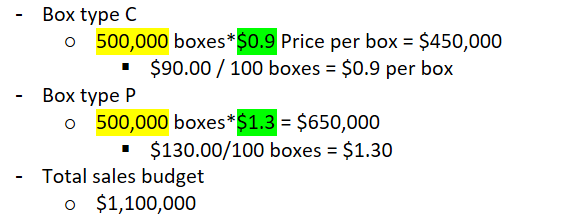ch.10 - budgeting
1/32
There's no tags or description
Looks like no tags are added yet.
Name | Mastery | Learn | Test | Matching | Spaced |
|---|
No study sessions yet.
33 Terms
types of budgets
Long range planning
Set long term goals
Strategies to achieve those goals
Plans to implement the strategies
Strategic budget
Goals used to develop a long range plan
Anticipate market trends
Master budget
AKA pro forma financial statement
Set up budgets that summarizes the goals of all of the subunits in the company
Consists of two classes
Operating
smaller Budgets used to prepare the budgeted income statement
need rev. and cash collections to make
Financial
capital expenditure budget
Cash budget
Budgeted balance sheet
Continuous or rolling budget
Updating the budget every month
pros of budgets
Requires all levels of management to plan ahead and form goals on a continuous basis
There are objectives to evaluate performance at each level of responsibility
Creates a warning system for potential problems
Communication and coordination is easier within the organization because you all have similar goals
Management has greater awareness of overall operations and the impact of the external environment
Motivates personnel
master budget components
Sales budget
Other budgets stem from this one
Production budget
You should know how much you are able to sell before you decide on how much to produce
DM purchases budget
DL budget
MOH budget
Ending FG inventory budget
Selling and administrative budget
Cash budget
Wages and salaries to personnel
Budgeted i/s
Budgeted balance sheet
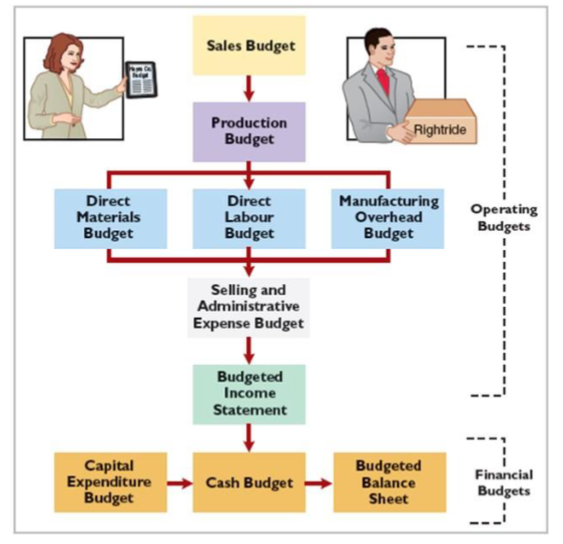
sales forecasting
Aka the cornerstone of all budgeting
Cuz every budget is based on what is forecasted
Usually determined by marketing
Find the sales for that industry and then what the company's share of those sales would be
A prediction of sales(A forecast) under a set of conditions
Realistic
Optimistic
Pessimistic
As you get closer to the time period, you pick a forecast and implement it for the sales budget
sales forecasting error
Q:
Suppose actual total revenue $480,000, not the $405,000 shown in this budget.
Suppose also that prices were stable. Costs would differ significantly from budgeted amounts in which of these budgets: direct materials budget, overhead budget, selling and administrative expense budget.?
A: In the situation where the actual revenue is higher than the budgeted revenue significantly, that means that the wrong sales forecast was used which affects every budget.
In this case, the price is the same but revenue has gone up which means that sales units has increased which will make for higher variable costs for the period
Factors to consider when sales forecasting
Economic conditions
Boom or bust
Past performance
Industry trends
Do market research
Plans for advertising and promotions
Will the budget for this increase or decrease?
What was our previous market share
The effect of changes in prices
Technological developments
sales budget
For each product:
expected Sales Volume* expected sales price per unit
budgeted rev used in I/S and cash budget
budgeted unit sales used in production budget
production budget
Want to find out the total units that need to be produced
Total units to be produced = total units to be sold
Inventories have to do with finished goods
leads to DM budget, DL budget, and MOH budget
Budget:
expected Sales in units
Add: desired ending inventory
(Less: expected beginning inventory)
= Production requirements
production requirements ex.
expected beginning inventory
ending balance of the period before/avg cost per unit
40,000 units/$5 = 8,000 units
For Jan.:
expected sales in units + desired ending inv. - expected beginning inv.
desired ending inv. = “maintain a minimum balance of … in fg”
12,000+10,000-8,000 = 14,000
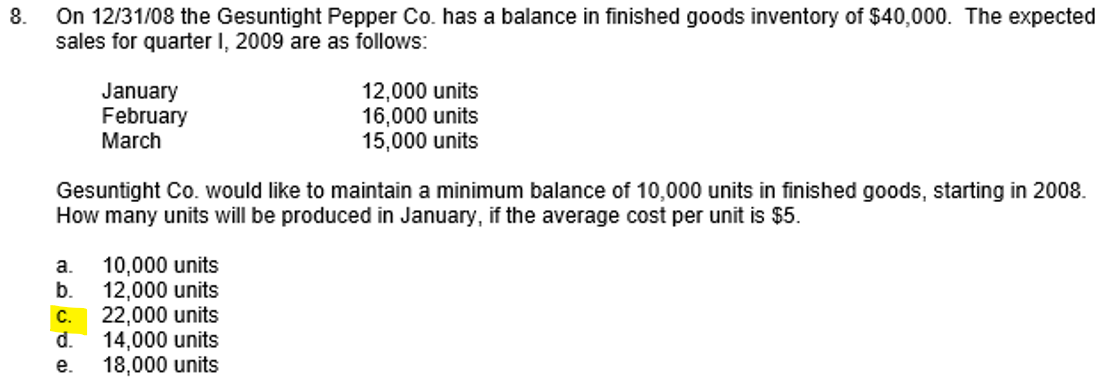
dm budget
DM that needs to be purchased in the period = DM required for production
However purchased will be in dollars, requirements for production will be in units
Budget:
Production requirements
Comes from the production budget
* DM required per unit
= DM required for production
This will give you units
Add: desired ending inventory
(Less: expected beginning inventory)
= DM to be purchased
DM to be purchased (in units)* price per unit
This will give you dollars
DL budget
Budget:
Production requirements
Comes from the production budget
* DL required per unit
= DL required for production
This will give you units
* DL rate per hour
= DL budget
This will give you dollars
mfg cost per unit budgeting
from DM and DL budget
Budget:
DM cost per unit
+ DL cost per unit
+MOH
Using the predetermined MOH rate
from the DL hours required for production or DM required for production
hours or units for ex.
also use from the DL required per unit or DM required per unit
hours or units for ex.
= Manufacturing cost per unit
ending FG budget
Desired ending inventory* manufacturing cost per unit
budgeted i/s
Sales
Total $ from sales budget
Less: (COGS)
For each product : sales in units * manufacturing cost per unit
= Gross profit
Less: operating expenses
Like selling and admin
= Profit before tax
Taxes
Tax rate* profit before tax
= Profit
cash collections
| Q1 | Q2 | Q3 |
Sales budget |
|
|
|
Estimated cash collections | From the last quarter of the previous year |
|
|
Accounts receivable Q1 Q2 | Usually given a percentage that will be collected in this quarter | 1-Q1% |
|
Cash collections from credit sales |
|
|
|
Cash collections |
|
|
|
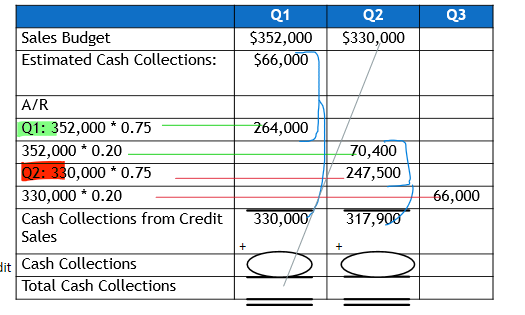
cash collection ex.
the amount that is expensed in feb. but will be collected in march
225,000*(3/4) = 168,750
the amount that is expensed and collected march
450,000*(1/4) = 112,500
total collection for march
168,750+112,500 = 281,250

cash collections ex. a % is cash sales and credit sales are collected the next month
physical cash collection for may:
150,000*30% = 45,000
credit sales collected in may = credit sales from april
250,000*(1-30%) = 175,000
total collection for may
45,000+175,000 = 220,000

ex. cash collection when there is a previous balance
jan. a/p balance from previous period
$12,000
jan. cash purchase payment
15,000*20% = 3,000
jan. credit purchase payment
credit amount of purchase
15,000-3,000 = 12,000
how much of the credit amount paid in jan.
12,000*(1/2) = 6,000
total jan payment
make sure to include a/p balance from previous period
12,000+3,000+6,000 = 21,000

budgeting admin
Levels:
Budget officer
aka chief budget officer
Specifies how the budget will be compiled
Budget manual
Specifies details on budget information
Who is responsible
When is it required
The form of the information
Budget committee
Appointed committee that advises the budget director
The amount of levels you have depends on the size of the company
Can have none
Multinational companies would need all three
budgeting ethics
Managers are usually rewarded for staying under the budget
but when costs are defined as cash payments for DM, DL, MOH
Managers will increase their payables which would decrease cash payments for the current period
There are ways to manipulate the accounting to reflect being under the budget
business ethics ex.
Q: manager does not participate in the budgeting process. The manager will be paid a bonus equal to ten percent of actual sales revenue in 2008. If the manager responds unethically to the bonus plan, what problem(s) for Healthworks, Inc could arise?
A: If the bonus is connected to the revenue then the likely course the manager will take is being neglectful in terms of costs which is bad for the company
participative budget
Managers and employees are integrated into the budgeting process
Pros
Managers have information and expertise that upper management might not have
Good for morale
Managers are less motivated if they're being told what to do rather than if they are sticking to a plan that they were a part of making
cons
can add too much padding so that easier to meet goals
more time consuming and costly
padding the budget
Setting budgetary goals that are easy to attain
Easily attained goals - realistic goals = budgetary slack
Used to deal with uncertainties
only if there is participative budgeting
ex. of the effects of padding the budget
Q:
sales price of these devices has been very stable over the last three years.If this manager padded his or her budget, what row of numbers in the budget would likely be affected most directly? Are these numbers likely to be above or below the manager's expectations?
A: The most affected row is the sales in units because a padded budget Lowers expectations which would mean less production
zero based budgeting
Developing a budget for each activity as if the company is in its first year of operations
So amounts from the previous period are not carried forward
This happens every few periods
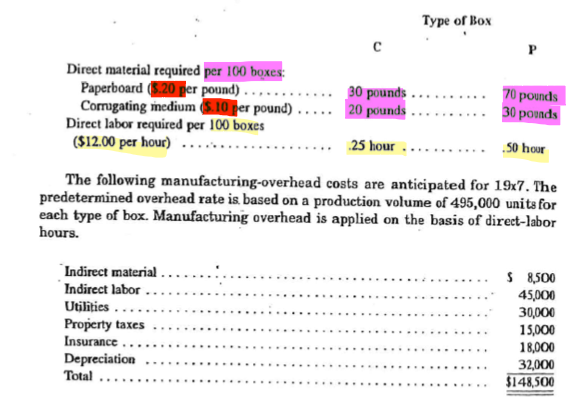
a big ex.
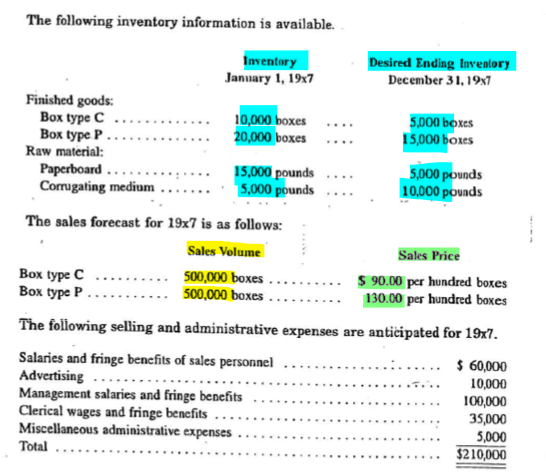
big ex. sales budget

big ex. production budget
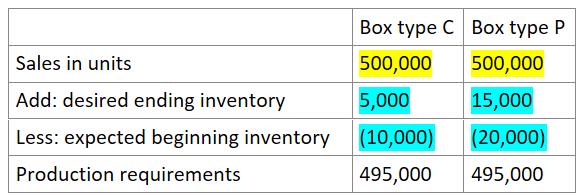 |
big ex. dm budget
For paper boards
DM required per box
C
70 LBS per 100 boxes = 70 / 100 = 0.7
P
30 LBS per 100 boxes = 30 / 100 = 0.3
| Box type C | Box type P | Total |
Production requirements | 495,000 | 495,000 |
|
DM required per box | *0.3 | * 0.7 |
|
DM required for production | 148,500 lbs | 346,500 lbs | 495,000 lbs |
Add: desired ending inventory |
|
| 5000 |
Less: expected beginning inventory |
|
| (15,000) |
DM to be purchased |
|
| 485,000 * $0.20 = 97,000 |
For corrugating medium
DM required per box
C
20 LBS per 100 boxes = 20 / 100 = 0.2
P
30 LBS per 100 boxes = 30 / 100 = 0.3
| Box type C | Box type P | Total |
Production requirements | 495,000 | 495,000 |
|
DM required per box | * 0.2 | * 0.3 |
|
DM required for production | 495,000 * 0.2 = 99,000 | 495,000 * 0.3 = 148,500.0 | 99,000 + 148,500 = 247,500 |
Add: desired ending inventory |
|
| 10,000 |
Less: expected beginning inventory |
|
| (5000) |
DM to be purchased |
|
| 247,500 + 10,000-5000 = 252500 then 252,500 * 0.1 = 25,250 |
big ex. DL budget
| Box type C | Box type P | Total |
Production requirements | 495,000 | 495,000 |
|
DL required per box | 0.25 / 100 = 0.0025 | 0.5 / 100 = 0.005 |
|
DL hours required for production | 495,000 * 0.0025 = 1,237.5 | 495,000 * 0.005 = 2,475.0 | 1237.5 + 2475 = 3712.5 |
DL rate per hour |
|
| 12 |
DL budget amount |
|
| 3712.5 * 12 = $44550 |
big ex. mfg cost / unit budget
|
| Box type C | Box type P |
DM cost per unit: Paperboards |
| 0.3 * 0.2 = 0.06 0.3 box | 0.7*0.2 = 0.14 0.7 box |
corrugating medium |
| 0.2*0.1 = 0.02 0.2 box | 0.3*0.1 = 0.03 0.3 box |
DL cost per unit |
| 0.0025*12 = 0.03 0.0025 box | 0.005*12 = 0.06 0.005 box |
Pred. MOH rate | 148,500/3712.5 = 40 |
|
|
MOH |
| 0.0025*40 = 0.1 | 0.005*40 = 0.2 |
mfg cost/unit |
| 0.06 + 0.02 + 0.03 + 0.1 = 0.21 | 0.14 + 0.03 + 0.06 + 0.2 = 0.43 |
big ex. ending fg. inv.
C
5000 *0.21 = 1050
P
15,000 * 0.43 = 6,450.0
big ex. budgeted i/s

